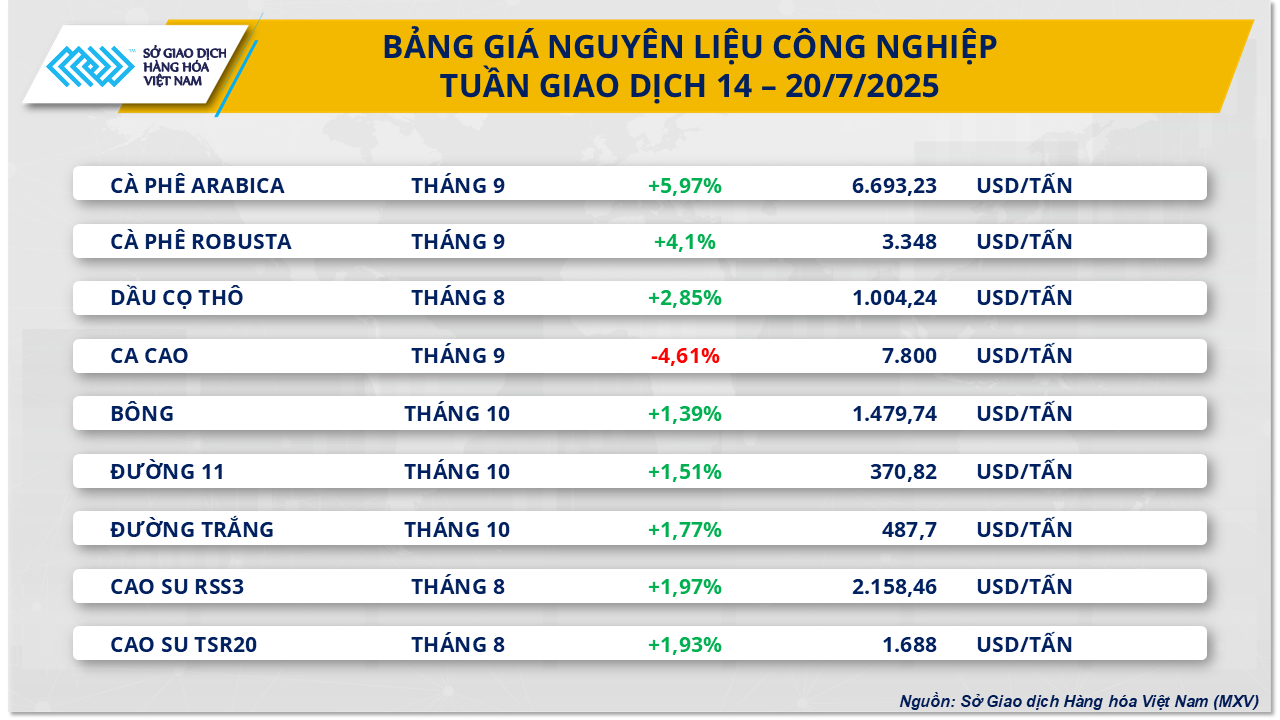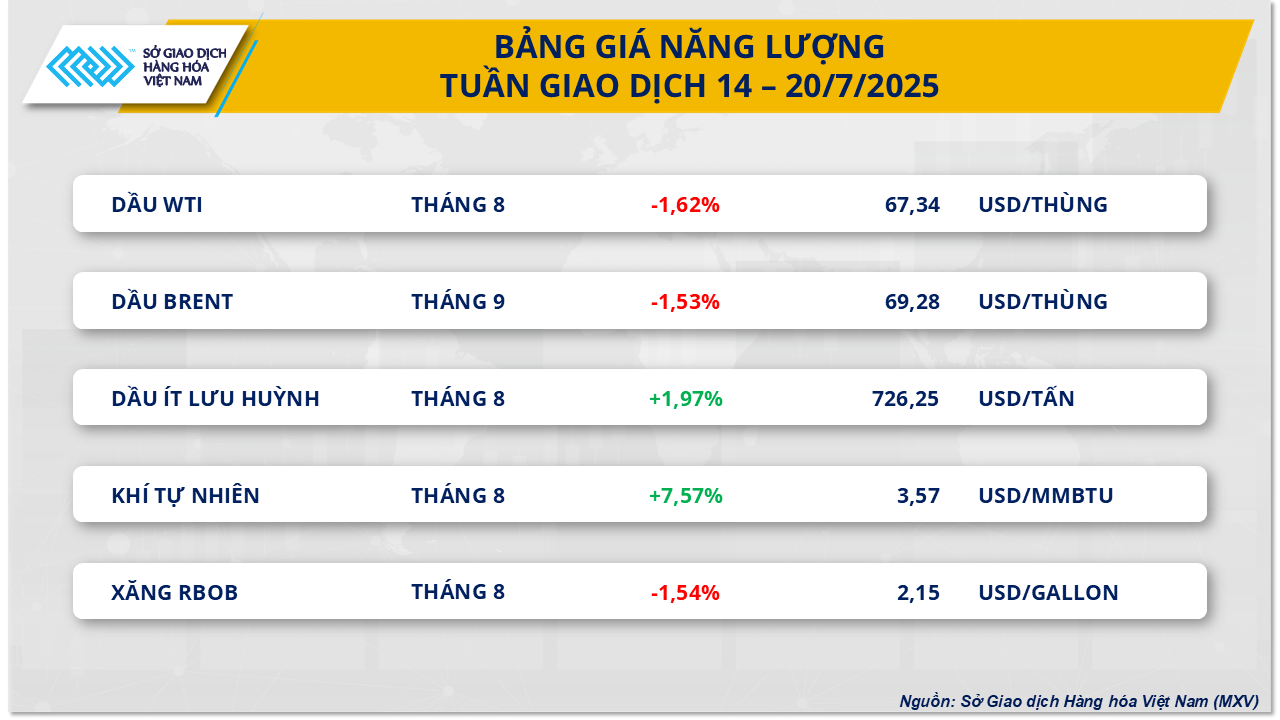For the industrial raw material group, at the end of the last trading week, the industrial raw material market witnessed overwhelming buying power with 8 out of 9 items. Of which, the price of Arabica coffee skyrocketed by nearly 6%, to 6,693 USD/ton, while the price of Robusta coffee also recorded an increase of more than 4% to 3,348 USD/ton.
According to MXV, low inventories have made Brazil’s coffee export prospects in the 2025–2026 crop year challenging. The country’s export output is estimated to be between 34 and 41.4 million bags, down 8.75% to 25% from the previous crop year’s 45.59 million bags.
In addition, last week saw a sharp increase in the net buying position of hedge funds in the Arabica coffee derivatives market, with an increase of 8.75% to 21,809 contracts. This development contributed significantly to the significant recovery of Arabica coffee prices during the week.
Meanwhile, production in Brazil is still going well. According to Safras & Mercado, as of July 16, Brazil had completed 77% of its 2025–26 coffee harvest, up from 74% at the same time last year. Dry weather has helped accelerate the harvest and put it ahead of last year.
Source: MXV
In addition, the new tariffs from the US also make it difficult for Brazilian coffee to access the world's largest consumer market. Currently, a week has passed since the Trump administration announced that it would impose a 50% tax on all Brazilian exports to the US starting August 1, however, high-level dialogue between the two countries has not yet been held. In the coffee sector, if this tax is activated, Brazilian coffee exports to the US - the world's largest coffee consumer and also the largest importer from Brazil - will face serious risks.
Heavy tariffs on Brazilian coffee threaten to disrupt the international market, as alternative sources of large volumes of Brazilian coffee are now virtually impossible. In 2024, the US will consume about 24 million 60-kg bags of coffee, of which 8.1 million will be imported directly from Brazil.
A study by the National Coffee Association (NCA) – an organization representing US coffee processing and trading companies – found that 76% of Americans drink coffee, and every $1 of imported green coffee brings $43 to the US economy , contributing $343 billion and creating 2.2 million jobs in the US. Brazilian coffee brings a lot of value to the US, so imposing tariffs will create a lot of pressure on the market.
On the weather front, the World Weather Service said earlier this week that some computer models were suggesting that colder weather could hit some coffee-growing areas in Brazil by the end of July. However, current forecasts suggest that temperatures will not drop to levels that would pose a risk to crops. While there is still a chance of a mild cold snap later in the month, experts say that overall weather conditions will be stable and will not significantly impact coffee production.
MXV believes that this week, world coffee prices, followed by domestic coffee prices, will likely continue to adjust and tend to increase in the first sessions of the week due to increased hoarding in the US before the reciprocal tax takes effect. Depending on the tariff developments and supply in Brazil, coffee prices will continue to increase or reverse and weaken at the end of the week.
In the energy market, according to MXV, the energy market last week recorded clear divergences. At the end of the trading week, Brent oil prices fell below the $70/barrel threshold, stopping at $69.28/barrel, corresponding to a weekly decrease of 1.53%. Similarly, WTI oil prices also recorded a weekly decrease of about 1.62%, down to $67.34/barrel.
Source: MXV
Geopolitical concerns have returned to global energy markets. On July 14, US President Donald Trump announced that he would resume support for Ukraine and impose sanctions on countries trading with Russia if a new agreement is not reached within 50 days. While there was initial speculation that the measures would take effect immediately, the move has complicated the political situation in Eastern Europe. In addition, the situation in the Middle East is heating up again, notably the escalation of tensions between Israel and Syria.
However, oil prices are still under great pressure from two other factors: global trade tensions due to the White House's tariff policies as well as the prospect of oversupply for the rest of this year. Currently, global crude oil demand is still supported thanks to the health of the world's two largest economies, which is much better than market forecasts; however, the market is still watching the latest move of the US Federal Reserve (FED) with the possibility of cutting the high base interest rate at the level of 4.25-4.5% is not high.
Faced with the downward trend in global crude oil prices, the Ministry of Industry and Trade and the Ministry of Finance have adjusted domestic retail gasoline prices accordingly. In the adjustment period on July 17, four out of five items were adjusted down in price, of which E5 RON92 gasoline recorded the highest decrease, about 0.91%; only kerosene increased in price. At the same time, the Ministry continued not to set aside or use the Petroleum Price Stabilization Fund. In addition, the authorities still maintained a reasonable difference between the prices of E5RON92 biofuel and RON95 mineral gasoline to promote biofuel consumption, in line with the Government's orientation.
Source: https://baolamdong.vn/thi-truong-hang-hoa-21-7-luc-mua-chiem-uu-the-tren-thi-truong-383045.html





























![[Photo] National Assembly Chairman Tran Thanh Man visits Vietnamese Heroic Mother Ta Thi Tran](https://vphoto.vietnam.vn/thumb/1200x675/vietnam/resource/IMAGE/2025/7/20/765c0bd057dd44ad83ab89fe0255b783)









































































Comment (0)